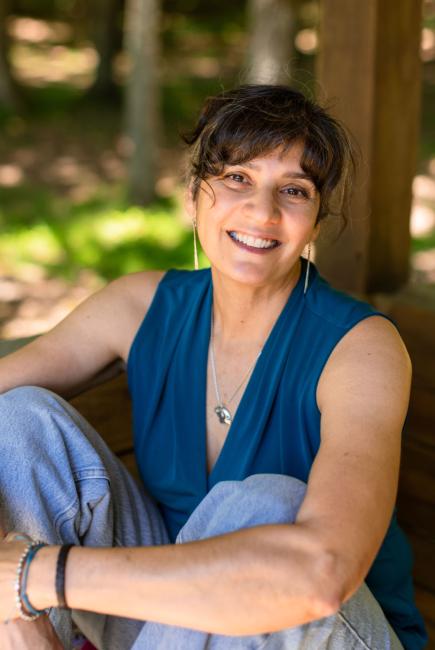
India’s Vanishing Vultures
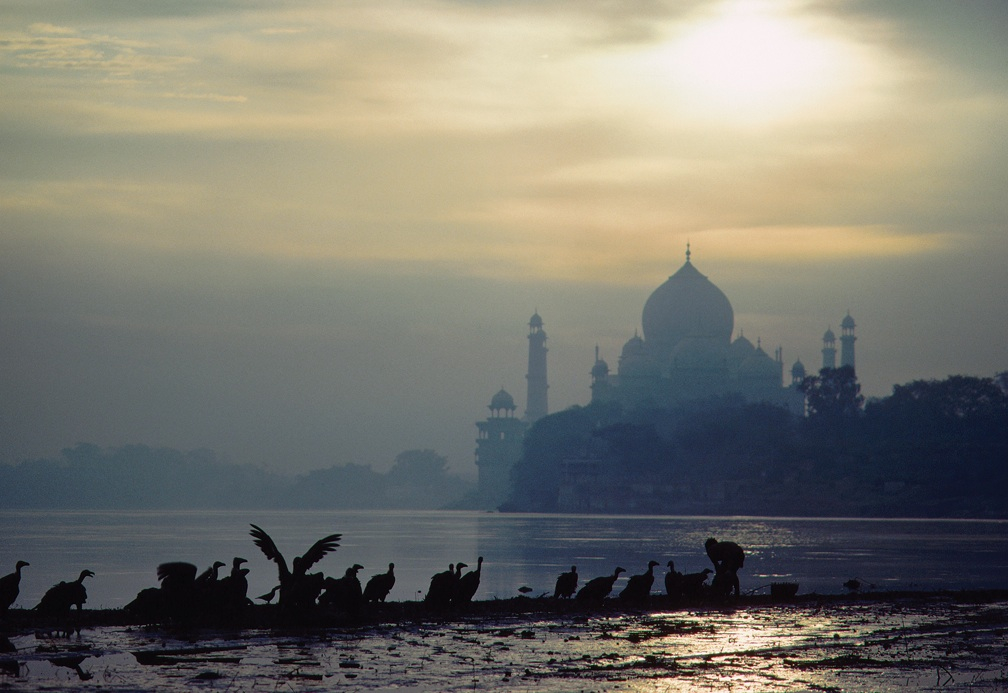
At first, no one noticed they were missing.
Vultures—massive and clumsy, their naked faces buried in rotting flesh along the roadside, on the banks of the Ganges, lining the high walls and spires of every temple and tower—were once so ubiquitous in India as to be taken for granted, invisible. And something in us didn’t want to see them. Vultures are cross-culturally uncharismatic—with their featherless gray heads, their pronounced brows that make for permanent scowls, their oversized blunt beaks capable of splintering bones. They vomit when threatened and reek of death. In South Asia, their broad wings can reach up to eight feet tip to tip, casting a great shadow from above as they circle, drawn by the distant smell of carrion. The world over, these voracious scavengers are viewed with disgust and associated with death—and we, instinctually, look away.
But for all of human history, vultures served India faithfully. They scoured the countryside, clearing fields of dead cows and goats. They soared over the cities in search of road kill and picked at the scattered refuse of the region’s ever-expanding populace. For a subcontinent where religious and cultural mores restrict the handling of the dead, human and animal alike—Muslims won’t eat an animal that hasn’t been killed according to halal; Hindus won’t consume cows under any circumstances—vultures were a natural and efficient disposal system. In Mumbai, they covered the Towers of Silence where Parsis, a small but ancient religious group that doesn’t believe in cremation or burial, lay out their dead for the vultures to consume in a ritual known as a “sky burial.” In Delhi, they flocked to the city dumpsites: one photograph in the archives of the Bombay Natural History Society (BNHS), India’s largest and oldest wildlife conservation organization, captures six thousand vultures in a single frame; another shows two hundred vultures on one animal carcass.
But, today, India’s vultures are almost gone. Vibhu Prakash, principal scientist with BNHS, noticed the first nascent signs of a crisis nearly fifteen years ago. He had studied bird populations in Keoladeo National Park outside of Delhi in 1984, documenting 353 nesting pairs of vultures. When he returned in 1996, there were less than half those numbers.
“I saw a lot of empty nests, and when I started looking, there were dead birds everywhere—under the bushes and hanging from the trees, dead in the nests,” Prakash told me later. “I was quite worried.” By 1999, not one pair remained. BNHS put out an alert, and biologists from all over the country confirmed that the three dominant species of South Asian vultures—slender-billed (Gyps tenuerostris), white-backed (Gyps bengalensis), and long-billed (Gyps indicus)—were dying across the region.
White-backed vultures were once the most common raptor on the Indian subcontinent, so omnipresent that census figures were approximate at best. “There were so many it was hard to count them individually,” Prakash said. “We’d see hundreds flying and count them by the tens or in groups of fifty.” Scientists have estimated that, as recently as the 1980s, thirty million white-backed vultures once coasted on thermals above South Asia. Now there are eleven thousand.
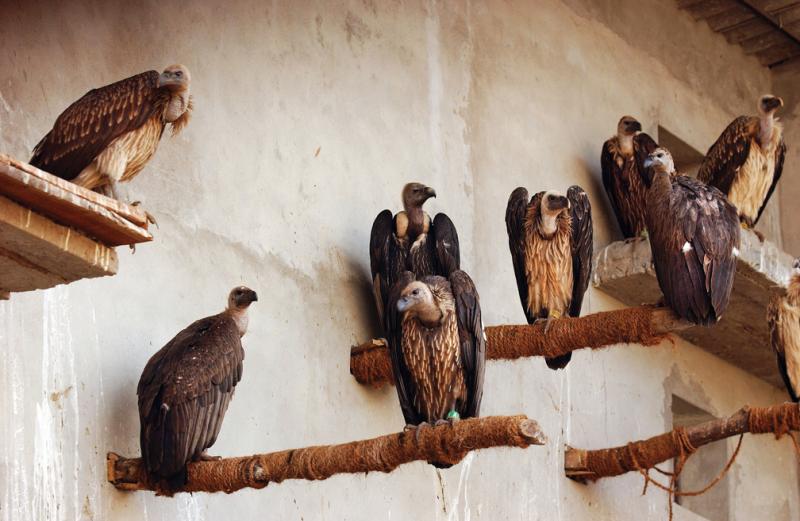
By 2000, the World Conservation Union classified all three species as critically endangered, the highest risk category, and the Indian scientific community called out to their international colleagues to help identify the cause of the crash. Initial speculation centered on an infectious disease or bioaccumulation of pesticides, similar to the devastating effects of DDT on predatory birds a half-century earlier in Europe and North America. Rumor blamed Americans—“so technologically advanced,” the Indians like to quip—for producing some new chemical that was killing the vultures. (After the Union Carbide disaster in Bhopal, it’s hard to fault Indians for their suspicion.)
But it was an American, Lindsay Oaks, a microbiologist at Washington State University working in collaboration with the US-based Peregrine Fund, who finally isolated the cause of the collapse in April 2003 and published the results the following year in Nature. The three species of Gyps vultures were dying from ingesting livestock carcasses treated with diclofenac, a mild painkiller akin to aspirin or ibuprofen. After taking it themselves for decades, Indians began using it in the early 1990s to ease the aches of their farm animals’ cracked hooves and swollen udders. For reasons that remain unknown, vultures that feed on animals treated with diclofenac develop visceral gout—untreatable kidney failure that causes a crystallized bloom across their internal organs. Death occurs within weeks.
Even after the discovery, it took two years for the Indian government to officially enact a ban on the sale of diclofenac for veterinary purposes. And, activist Nita Shah told me, most veterinary stores still keep the non-steroidal, anti-inflammatory drug under the counter, and quack vets use it regularly. “In a high-density livestock area, ten thousand vials of painkiller are being used monthly in just one district,” Shah said. Present tense. Are being used, ban be damned. “The ban,” she concluded, “is ineffective.”
Thus, vulture numbers in the region had plummeted by 97 percent—the most catastrophic avian population decline since buckshot wiped out the passenger pigeon. Just fifteen years ago, there were at least fifty million vultures on the Indian subcontinent; today, according to Britain’s Royal Society for the Protection of Birds, less than sixty thousand individuals of the three species survive in the wild—and a newly-completed Indian-sponsored census, the first in three years, is yielding even more distressing results. Several hundred long-bills still fly over the cliffs of Ranthambhore in Rajasthan, some perch high on the domed pavilions of Orchha’s cenotaphs in Madhya Pradesh, and I have seen a colony of twenty white-backs on stick nests in the crooks of trees along a hidden riverbank in Bandhavgarh, but some scientists have started calling these species “functionally extinct” and refer to their own research as “monitoring to extinction.”
No longer a mystery, the vanishing of India’s vultures now presents a still greater challenge. India must find a way to restore its prime scavenger or risk untold human health consequences. Vultures once rid the landscape of diseases such as tuberculosis, brucellosis, and foot-and-mouth. Their strong stomach acids and high body temperatures allow them to ingest an anthrax-infected carcass and suffer no ill effects. The fear is that with vultures gone, and the human handling of dead livestock increasing, that these diseases could spread among both animal and human populations.
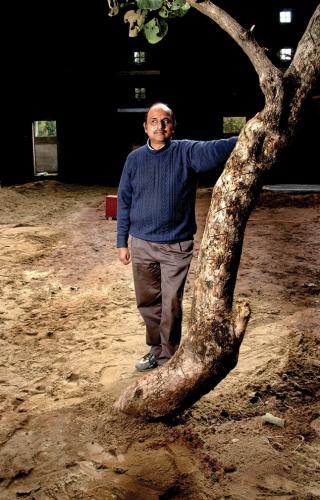
On a five-acre plot leased to them by the government, Prakash and his wife Nikita, along with a staff of ten, operate the center where most of the seminal stock for the BNHS captive breeding program lives within the confines of three concrete aviaries. It is a vulturized version of the ark. In the Hindu account of the Great Flood, it was the heroic king Manu, son of the Sun, who was told to take the beasts of the world onto a ship for safekeeping. Manu, like the Western world’s Noah, became the keeper of a genetic repository.
The Pinjore center, opened in 2004, was the first of four proposed breeding facilities across India that were part of a vulture recovery plan created by the government in 2004. Only two others have opened, and only Pinjore comes anywhere close to having twenty-five breeding pairs of each of the three Gyps species, the goal set forth in the plan. Either there weren’t enough birds to collect, or they were in locations too remote to access, or bureaucrats denied biologists permission to carry vultures across state borders. For Prakash, everything is riding on the Pinjore center.
No sooner had my driver entered the gate than the dead goats arrived. Twice a week, Prakash trucks in certifiably diclofenac-free goats to feed the hungry vultures. Staff members unloaded eight carcasses—skinned and slippery, fresh and odorless—from the back of a jeep. They lashed cheap plastic aprons around their waists and hooked blue sanitary masks over their ears, but their hands were bare and their feet in flip-flops. With whacks of a machete, they divvied up the goats. This clean meat is the single biggest expense for the center. Each month, they spend thousands of dollars in order to feed the birds—more than they spend on all the staff salaries combined. Lack of funding is a persistent challenge and threatens the viability of the project. It’s much easier to woo funders to open their checkbooks for tigers or elephants than carrion-eating birds.
The assistants fit carcasses into tall blue buckets and disappeared in pairs toward the buildings in the surrounding woods. In order not to disturb the vultures, they opened a small hatch in the long side of the building to slip in the bodies. It was breeding season, and even if some of the birds were accustomed to small intrusions, others might get jittery, risking tossed eggs, abandoned incubation and general nest failure. For birds that only lay one egg per year, if they lay at all, it is a risk the center can’t afford to take.
Since the aviaries were off limits to visitors, I headed inside with Prakash’s wife Nikita, a small woman with a youthful air, to spy on the white-backed vultures via closed circuit television. With a flick of her finger, she guided the camera as we scanned the aviaries, constructed around existing trees and open to the sky but for protective netting. Here, she told me, the birds could do everything that a wild vulture could—except, she acknowledged, soar for hundreds of miles as they do when free. She zoomed the camera in on the two fresh goats that lay on top of a large pile of bones. Gradually, the vultures descended from their perches on the concrete ledges and jute platforms suspended high up along the walls where they had meticulously built nests out of leaves and sticks.
Breeding vultures in captivity is a tentative experiment, and basic biology is against the scientists’ chances for success. Of the thirty-two vultures I watched in the white-backed aviary, there were only twelve established pairs. They build nests for six weeks before the mother lays a single egg. Together, the parents keep it warm during two months of incubation, and, if the egg hatches successfully, keep the young fed for another four nest-bound months before the inaugural flight of a fledgling bird. It will take the offspring five years to sexually mature. The process is slow and yields minimal results; only seventeen vultures have been bred successfully at Pinjore in the last three years, not even enough to make a dent in the population’s continued rate of decline.
Ten minutes after the goat delivery, the first vulture stepped up to one of the carcasses. A minute later, there were ten, and a minute after that, the goat was entirely concealed by a venue of vultures turned inwards, wings flaring, heads moving up and down, feathers flashing in the sunlight. It was carnal and primal. Nikita told me they are aggressive toward the meat but not to each other.
Within another ten minutes, the frenzy had already subsided. Exposed bones jutted out from half-eaten flesh, and a one-winged bird climbed to the top of the carcass. He was a rescue bird, Nikita told me, saved from the Uttaran kite-flying festival in Ahmedabad, where boys dip their kite strings in shards of glass to cut the competitors’ lines, and inadvertently bring down dozens of vultures and other birds in the process.
Most of the satiated vultures stepped away from the carcasses. One sat placidly, its wings and tail falling like a ladies full skirt down to its broad blunt talons. The fluffy ring of downy feathers that encircled its long bare neck added a Renaissance air.
“So white—snow white,” Nikita said softly, smiling.
I found Nikita’s apparent love for the birds contagious. I felt the same intimate wonder I have when watching any creature up close, but there was something else that I can only define as a pre-nostalgia, an ache for something that will soon be gone. The image on the screen before me was live, but there was the likelihood that one day soon, all that would be left was the image, a ghostly recording of something that once was.
“Come, I’ll show you,” Vibhu Prakash said. Back outside, the sky had clouded over into gray. The feeding had stirred the normally silent vultures, and the forest was alive with their screeching. It sounded like a hundred ancient creaking doors, a primeval sound. The scratchy racket faded as Vibhu led me down the path to a sheltered enclosure. Bird C99 had been found lying in a field eighty kilometers away and taken in by a village family that didn’t understand why it wasn’t eating the flour chapathis and milk they were feeding it. I peeked at it through bamboo slats. It sat high on a perch encircled with coconut rope, wings relaxed at its sides and bare head up and alert.
“It was so weak,” Vibhu whispered to me, “that you could just walk up to it and pick it up.” But once they put meat in front of it, red and raw, the vulture ate on its own and soon regained its strength. If it had eaten pesticides or other chemicals, at least it wasn’t diclofenac, or the bird would be dead.
“It is still too used to humans,” he murmured. “The others would be throwing up in response to our presence right now.”
We turned and walked back toward the office. Vibhu is a round-faced man in his late forties and naturally soft-spoken, but his voice rose as he talked about vultures, these birds he had never really studied until they started to vanish. “Without tigers and elephants, the ecology can still work, their role has been taken over, mostly by humans. But nobody can take over the role of the vulture. They are very efficient scavengers. Nothing will ever be able to fill that niche.”
We had almost reached the office when Vibhu paused by a massive banyan tree, pointing. “Earlier this banyan tree had six or seven vulture nests in it. Wherever you looked in those days, there’d be nests.” He resumed walking, his voice soft again. “It’s so hard to imagine now.” He seems simultaneously defeated and determined.
Some have criticized Prakash’s work with BNHS, claiming that keeping vultures in captivity is wrong, that BNHS is serving some unidentified self-interest. They argue instead for “vulture restaurants,” where diclofenac-free meat is dumped in open fields to attract wild birds. Prakash has no patience for such criticism and believes that a restaurant model is ineffective for the wide-ranging vultures. It is Russian roulette. Wild birds are still at risk of coming across deadly meat; just one tainted carcass could kill dozens of birds. Prakash knows captive-breeding is slow and may be ineffective, but he doesn’t see a better choice.
“We wish we didn’t have to do this,” he said. “It is a big headache to raise these birds.”
Even if the breeding is successful, if BNHS can raise the funds—more each year—and find the biologists willing to do the unpraised work, even if vultures accept their new confines, what then? There is no hope for the ultimate stage of a captive breeding program—release—unless
diclofenac is completely removed from the environment. Each year, there will be more vultures to care for, and the ark will need to expand, and yet the floodwaters continue to rise each time a farmer pricks the rump of an ailing cow with a shot of diclofenac.
By the time Prakash and I had returned to the office, the distant sound of the feeding vultures had diminished. He looked up, an unbreakable habit among those who work with birds, as a single white-backed vulture crossed the pale blue sky, one of a wild pair that frequent the area around the center. Was it aware of the white-backs held in captivity just below it? I tried hard not to anthropomorphize, but how could the solo flyer not look lonely, be lonely? At some point, perhaps soon, there could be just one bird somewhere over South Asia that will be the very last one. And then there will be none.
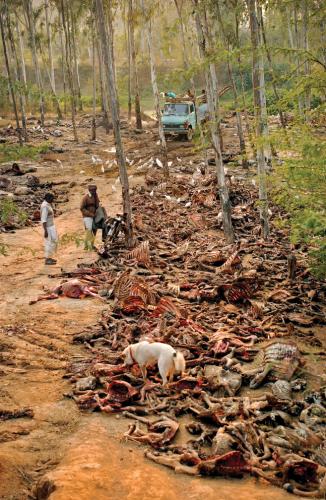
When I met Rameshewar, he was wearing a thin button-down shirt that had a neat tear in the back, and his hair was thick, a raven’s black that matched dark eyes that politely avoided mine. He looked young, no older than thirty, though his wife was already matronly with motherhood.
“I’ve been here for four years,” Rameshewar explained. “I live here with my wife and four children. These are my four goats, which we keep for milking. Tractors come every day carrying carcasses—” Something captured his attention behind me.
“Heyyahh!” he yelled, his soft voice suddenly rising, as he shooed the goats away from the open doorway of his hut. They went scurrying but remained close.
Overhead, hundreds of birds kettled in slow circles in the sky—mostly Eurasian griffons, bulky steppe eagles, and Egyptian vultures the size of large gulls—all riding the warm whorl of desert thermals to the top of the gyre without a single flap of their wide wings and then peeling off like a slowly cascading waterfall. As far as scientists can determine, diclofenac hasn’t affected these scavengers. On the ground, more birds perched in the trees, and others vied with the dogs for the fresh meat of the newest arrivals to the dump. The white-backed and long-billed Gyps vultures hardest hit by diclofenac were noticeably absent. In the past six years, only one individual had been seen.
When the carcasses arrived twice each day, Rameshewar and his wife Pandevi leaned over them with a knife and removed the hides, and then left the bare bodies for the animals and elements to dismantle. Their eldest son, at thirteen, worked as a laborer on the tractors that brought the deliveries. Together, they layered the skins with a desiccant in covered sheds at the side of their encampment, which consisted of a thatched hut that listed to one side and an outdoor earthen platform with a sculpted fire pit for a kitchen. Their two younger sons were in and out of school and sometimes stayed with the grandparents in town, but their daughter lived with them. Outside, in the sun, the dusty desert ground was littered with goat hooves, stray tails, a single shoe, and the plastic bags that have become an integral part of the Indian landscape.
For every ounce of Rameshewar’s leanness, his wife Pandevi was full and round. She smiled easily, her dark skin in contrast to the bright orange paisley dress she wore. A solid gold flower bloomed from the side of her nose and a black circular bindi graced her third eye. Her sole concern, it seemed, was the growing threat of feral dogs.
“Many go and roam, two-three kilometers from Jorbeer,” she said, her voice raspy.
“In the late night, I am very afraid of the dogs. If I have to go out at night for the toilet, I take a stick,” she said. “During the day, we’ll carry a stone, but most of them know us and it’s usually okay. But in the night, and when they are in the mating season, they are different.”
I had been hearing a lot about dog attacks. Most barely make the news, but I heard the stories as I traveled around. Two girls in Bikaner were sleeping. They were eight or nine years old and had no home, no roof for shelter, no walls to keep out the night. They were not far from the carcass dump at Jorbeer. The girls were such easy prey, motionless in sleep, the smell of their young flesh a call to a hungry carnivore. The dogs approached. The dogs attacked. The girls lived, but other dog-attack victims, many children, like a four-year-old boy named Manjunath in the city of Bangalore, do not.
One study estimates that 70 percent of the world’s rabies deaths occur in India, where there are more than seventeen million dog bites each year. In the decade of major vulture decline, from 1992 to 2003, one estimate showed dog populations increasing by a third, up to nearly thirty million. The escalation of the dog population corresponds perfectly with the disappearance of India’s vultures.
“I’ve seen the number of birds go up,” Rameshewar said, “but I’ve also seen the dogs coming, each day, more and more. In the morning, the dogs can get very restless when the new bodies come in. They’re hungry from the night. We have to fight them off as we unload.”
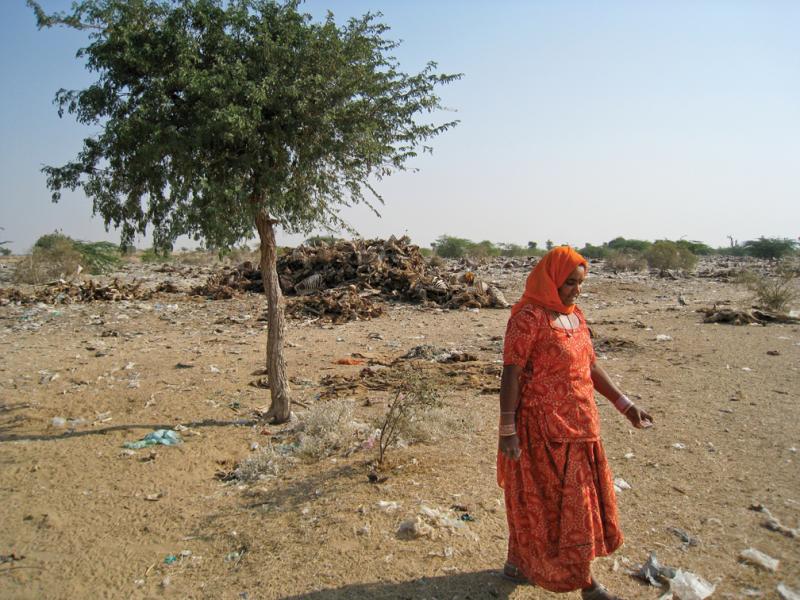
A forest official told me there were no more than one hundred fifty stray dogs at Jorbeer; Rameshewar estimated two thousand. The true figure is likely somewhere in between. I tried to make my own count, but in the midday heat, the dogs were scattered, seeking shade under bushes and acacia trees, ten here, three there, twenty vying for their positions around the newest carcass, flushing birds away that came too close. A female dog, teats hanging low, bared her canines at a couple of other females, defending her three young pups that frolicked among the carnage. As I passed, dogs looked up and growled from a hundred feet away. Most of them seemed strangely healthy, thick with arrogant muscles, unlike the cowering, scrawny strays I’m used to seeing on India’s streets.
Only a few looked sick, very sick, some completely lacking any fur, their skin sagging like an elephant’s, their ribs exposed like the mounds of death they fed upon. These were the ones with dermatitis, which has been moving through the population, killing up to 40 percent of the pack according to one local biologist. The fatal disease has begun to show up in the wild gazelles that also pass through Jorbeer, likely contracted from the dogs, the links within the ecosystem tight couplings of connection. Even with the high mortality rate—dermatitis accomplishing an extreme form of dog control that the government is unwilling to do, in spite of the threat of rabies—the dog numbers were still on the rise. Where there used to be ten dogs to every hundred vultures, the ratio has now flipped.
Two days later, I returned to the dump with Jitu Solanki, a local biologist who is the type of man who can spot an owlet in a dark hole of a roadside tree while driving a car down a narrow desert road at forty miles per hour. There’s not much paid work for naturalists in India, though, so he runs a guesthouse and leads desert safaris as a way to extract a living from his knowledge. He comes to the dump often to watch birds and briskly pointed them out to me.
There were black hawk-like kites and cawing crows, and a few cinereous vultures, massive black figures with an air of royalty. One landed in a treetop, bending the bough with its weight, and scattering eagles to the lower branches, dwarfing them. I saw the slender white wisps of cattle egrets standing inside the remains of a massive rib cage, picking at the leftover flesh. There were drongos with long forked tails, and hoopoes with black-tipped fanned crests like some Indian punk mohawk, and cooing mourning doves. A black ibis had its delicate downward-sloping bill buried in an unidentified body part, a thick coagulated substance the color of cabernet. Skeletons were piled fifteen feet high, some but not all of the meat picked clean, awaiting the arrival of bone collectors who will grind them for fertilizer or gelatin.
Solanki was comfortable around the feral dogs, but he was protective of me as we stepped out of his little car. He was still identifying different birds when the dogs suddenly roused and started barking, gathering together in anticipation of something we couldn’t detect. He paused, mid-sentence, and watched.
“Do you worry about the dogs?” I asked.
He looked at me gravely and, in a serious rasp, said, “Yes.” His estimate, and the one I trusted the most, was that there were a thousand dogs at the site. “Dogs are a big problem. They are really too much.
“A few months ago, they came with tractors and—” He makes a quick whistling sound and a universal scissoring gesture with his fingers to indicate that the dogs had been fixed. “They put ID tags on them, so maybe in two years it will work. But they never kill dogs here. Hindu people, you know, there is a lot of god and all. We have a god we call Bhairava, a reincarnation of Shiva, and his vehicle is a dog, so people believe that if you kill the dog, Bhairava will be angry.”
Solanki looked up into the sky. “In Hinduism, if you see any god, you will find some related bird or animal, and it is a very nice way to conserve wildlife. Even the vulture that people relate with death and don’t like, this bird is the Hindu god Jatayu who tried to save Sita when she was kidnapped. So even the ugly vulture has a place with the gods.”
Far from the Jorbeer dump, in a posh partof Mumbai, the Parsis continue to lay out the bodies for the vultures that no longer come. Once, it was the perfect system of human disposal. Since the days of their prophet Zarathustra, Zoroastrians have used dhokmas, Towers of Silence, for sky burials. While the vast majority of humans on earth choose to bury or burn their dead, Parsis believe that earth, fire, and water are sacred elements that cannot be polluted by a human corpse. In their native Persia, they placed bodies on natural stone promontories exposed to the sun and vultures would descend to feast. When they migrated to India in the eighth century, escaping persecution and becoming known as Parsis, they continued the tradition on 155 forested acres known as the dongerwaadi in the heart of Malabar Hill, today Mumbai’s toniest neighborhood. They built a series of squat towers, now mottled with moss, where the bodies are still placed after priests have said the prayers and a dog turns its head away in disinterest from the body. It is a ritual so ancient that Herodotus noted it in The Histories in 450 BCE.
The Parsis, like the vultures, are dwindling in number. There are only an estimated hundred thousand worldwide, more than half concentrated in Mumbai. According to the traditionalists within their ranks, conversion and intermarriage are forbidden.
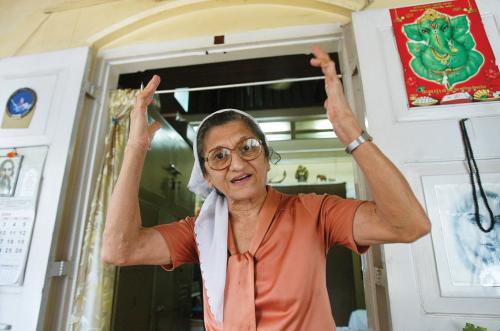
As we wound uphill, she pointed out one of the solid basalt cylindrical structures, wide but not too high, through the leaves of the lush forest. It was gray amid the green, as though a mirage within the forest, filled with butterflies flitting about and peacocks sitting on the low branches of trees. A colony of fruit bats, like big black dewdrops, dangled from the upper branches of a nearby tree, chittering.
She also pointed out all the bare ground that could be used as a cemetery—there and there. A faithful Parsi, she lamented the vultures’ disappearance, but it was time to adapt. She came to this conclusion after she learned that her mother’s body, months after her death in 2005, was slowly rotting away, exposed and naked atop the towers.
“When I was at the dongerwaadi praying, I asked the nasarsarlas if my mummy was gone, and their response was laughter!” she said, her hands raised in disbelief. “‘No, no,’ they told me. ‘You’re mother will be there for years to come!’ There was talk of the bodies not decomposing, but who wants to think of such things?”
She did. Wanting to know the truth, she hired a photographer to sneak into the towers and document what was happening. The images first appeared on flyers in Parsi mailboxes and eventually wound up on CNN. There was an uproar. The Bombay Parsi Panchayat, the religious governing body, had assured everyone that even without the vultures, everything was just fine on the towers. The photographs proved otherwise.
At the end of the path, we stood at an elaborate metal gate that stood between stone supports, a large lock sealing it shut. Baria, a mischievous look upon her face, directed my attention to the left of it. A body-width section of fence was peeled back, enough for a person or two, perhaps with photography equipment, to slip through quite easily.
There hadn’t been a vulture seen in years, but hawk-like black kites circled in great numbers over our heads. Every day, an average of three more bodies arrive for them, and they feast as the vultures before them, but their habits are messy, focused on the soft spots, leaving too much behind. There were complaints of the smell and rumors of fingers showing up on the balconies of nearby high-rises.
The Panchayat has attempted to replace the service that the vultures provided so seamlessly for so long with a series of failed technologies. The ozone machine didn’t really help with the smell. The chemicals they poured into orifices made things slippery as the bodies melted onto the stone. They’ve settled on solar reflectors installed atop steel scaffoldings and directed at the bodies to speed up the process of decay. (Imagine a child with a magnifying glass aimed at an ant.) But the rainy season is four months long and solar devices desiccate more than destroy the bodies. The most orthodox of priests claim that it’s a back door to cremation.
Khojeste Mistree, a Parsi scholar and member of the Panchayat, agrees. On a separate visit, I stood at the same spot with him, though he didn’t point out the breach in the fence. With a good girth and a trimmed gray beard, his face was unlined, a man untroubled by self-doubt.
“People say the Towers of Silence are antiquated, that we should move on to cremation and forget our tradition,” he told me, speaking in a precise Cambridge accent, though it’s been thirty years since he studied there. “I’m totally opposed. This powerful, vociferous minority of reformists doesn’t know the religion.” He clarified that he wasn’t a priest.
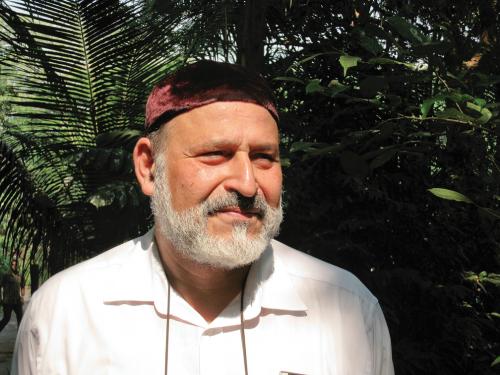
I found him pleasant for a puritan.
Mistree has a grand plan. He imagines a vulture aviary, sixty-five feet high, as big as two football fields, spanning the towers and the trees without cutting a single branch. Critics, and there are many within both the Parsi and scientific communities, say an aviary would lead vultures to their deaths. Diclofenac is present in hundreds of human painkiller formulations. It would be virtually impossible to ensure that the Parsis were, as the goat meat at the breeding center in Pinjore, diclofenac-free. But Mistree is determined. He even went so far as to suggest that the Parsis were already keeping some vultures, somewhere—though as a protected species, doing so would be illegal.
“Where there is a will, there is a way,” Mistree stated. “Really, we are more concerned than anybody that the vultures survive. Our interest is in the very preservation of our religious tradition. We’re more invested than those armchair conservationists.”
Even with his dismissal of BNHS’s breeding work, his acknowledgment of how irreplaceable the vultures are echoed what Prakash had told me in Pinjore. “Vultures play such a beautiful, natural role in our death ritual,” said Mistree. “To replace them is a unique challenge.”
While the Panchayat struggles with the burdensome bodies in theory, the Parsi undertakers are presented with a more tangible mess. For generations, their job was to carry an intact body up and lay it on the tower roof, a sloped circle tilting in toward a central well from which three concentric rings radiate out like ripples. Men are on the outside, women in the middle, and children on the inside, each ring smaller than the last. The vultures would set to their task, and within days, the nasarsarlas could push the bones into the ossuary at the center.
The nasarsarlas are the poorest of Parsis, and I imagine they might miss the vultures more than anyone else on the subcontinent. Farmers have a dead cow every now and again that needs to be attended to, and the dogs at the carcass dump have to be treated with caution, but every single day the nasarsarlas have to face a new batch of bodies when the old ones have not yet disappeared.
Like Baria, others are ready to allow burial or cremation into the Parsi parameters of worship, eager to find their own way to adapt to the vultures’ absence. Some Parsis have suggested they move from the ancient to the cutting-edge of green technology, using gasification, which involves high heat, but not in direct contact with the body, or promession, a technique catching on in Sweden that uses liquid nitrogen to deep freeze a body before vibrating it into a fine dust. One prominent bird breeder suggested they try insects, but all the recommendations have been met with lukewarm enthusiasm. For now, they continue to aim their solar collectors as best they can and hope their towers aren’t ruins in the making.
Ashes to ashes, dust to dust, bird by bird.
“They’re gone. They’re gone. They’re gone,” he said, shaking his head. These were the first words that Dr. Asad Rahmani, the director of BNHS, uttered when I sat down with him in Mumbai.
I realized as I spoke with Rahmani that I had come to India looking for an eco-catastrophe. Though the vulture is the unloveliest of creatures, though few cared for them while they were here nor notice that they are missing, their absence has left a void. There is a physical abyss that is filling with dogs that can be ferocious, and a spiritual vacuum that is forcing questions of adaption for the most orthodox of India’s Parsis.
Yet it didn’t feel apocalyptic to me. Maybe all of us, whether guided by God or by science, secretly want to be the ones living in the end times, as though it bestows some epic importance upon our little lives. But what if there is no ultimate annihilation, but instead a million daily deaths, literal or figurative, that no one quite notices? The vultures’ disappearance is catastrophic, yes, but the ability to adapt is stunning. Or terrifying. Or both. No matter how bad things get, how many species get wiped from the earth in humanity’s steady march of population and progress, the living go on. Those species that disappear are erased from the bio-narrative of the planet and forgotten within a generation that only knows of what came before through chance encounters at museum exhibits, a grandmother’s knee, or a picture on a computer screen. Already, there are children turning into teenagers in India who have never seen a vulture, though their parents knew skies filled with swirling kettles of the scavengers for most of their lives. With the vultures becoming functionally extinct in under a decade, India’s ecology has shifted and the habits of her people, whether farmers or skinners or Parsi priests, have yielded in transition. What if we adapt too easily?
This is what Rahmani was suggesting.
“I wish we were not so flexible. We’re like pests. We can live in every type of environment, from Alaska to Namibia. We’re omnivorous. We’re like cockroaches, rats, and bandicoots,” he said.
“You have seen the slums,” the biologist continued. “Look at the horrible conditions we can live under and still have reproductive success.”
He leaned back in his chair and the continuous insistent blast of car horns drifted up from the street, filling the space between his words.
“No other species has such a huge tolerance. For the earth, that is the unfortunate part. If we had a very narrow tolerance of pollution and food and all these things, maybe we would take more care of the earth.”
He spends his days supporting the multiple efforts that are underway to save the vultures, but his words belie the hopeful actions. Or maybe they reveal his ultimate faith in ecology.
“Nature is dynamic. It is not the balance of nature; it is the dynamism of nature. It is a terrible thing to think of a world without the vulture, but what does it matter? Nature settles itself. As an ecologist, I know this.”
Yet he still lamented the disappearance of the many Jatayu vulture-gods that once flew on their epic wings above his country. He told me more stories of the abundance that once was, of the tree behind his house that was filled with nesting birds, where his parents told him not to go near but which they accepted as part of their natural world. He ached with sorrow.
“There were so many vultures then that you can’t even think they could decline,” he said. “Oh, don’t remind me of those days; it is so painful for me. Just to imagine that they would become rare was impossible. What happened to them? What have we done with them? Now there are dogs. They eat anything, live or dead. There are dogs on the ground but the skies are empty.”

